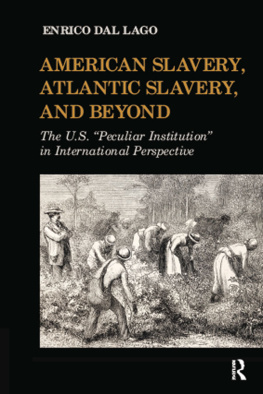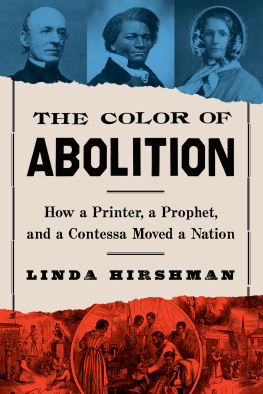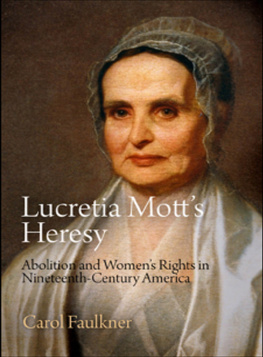Published by Louisiana State University Press
Copyright 2013 by Louisiana State University Press
All rights reserved
Manufactured in the United States of America
FIRST PRINTING
DESIGNER: Mandy McDonald Scallan
TYPEFACE: Calluna
PRINTER AND BINDER: Maple Press
Citations from the Anti-Slavery Collection, Rare Book and Manuscript Division, Boston Public Library, are reproduced courtesy of the Trustees of the Boston Public Library/Rare Books Department. Citations from the Massachusetts Historical Society collections are reproduced with permission of the Massachusetts Historical Society, Boston.
Library of Congress Cataloging-in-Publication Data
Dal Lago, Enrico, 1966
William Lloyd Garrison and Giuseppe Mazzini : abolition, democracy, and radical reform / Enrico Dal Lago.
pages cm. (Conflicting worlds : new dimensions of the American Civil War)
Includes bibliographical references and index.
ISBN 978-0-8071-5206-5 (cloth : alk. paper) ISBN 978-0-8071-5207-2 (pdf) ISBN 978-0-8071-5208-9 (epub) ISBN 978-0-8071-5209-6 (mobi) 1. Garrison, William Lloyd, 18051879. 2. AbolitionistsUnited StatesBiography. 3. Antislavery movementsUnited StatesHistory19th century. 4. United StatesPolitics and government18151861 5. Mazzini, Giuseppe, 18051872. 6. StatesmenItalyBiography. 7. DemocracyItalyHistory19th century. 8. NationalismItalyHistory19th century. 9. ItalyPolitics and government1815-1870. I. Title.
E449.G25D35 2013
326'.8092dc23
[B]
2013001846
The paper in this book meets the guidelines for permanence and durability of the Committee on Production Guidelines for Book Longevity of the Council on Library Resources.

CONTENTS
INTRODUCTION
Garrisonian Abolitionism, Mazzinian Democratic Nationalism, and Transnational Comparisons
1. EARLY ATTEMPTS AT DEMOCR ATIZATION
The Making of Two Radical Leaders, 18051830
2. EXERCISES IN MEDIA PROSELYTISM
Journalism and Revolutionary Apostolate, 18311833
3. WORKING TOWARD GLOBAL MIDDLE-CLASS INCLUSIVENESS
The Fight for Freedom from Local to Federal, 18331837
4. CONFRONTING IDEOLOGICAL INERTI AS
Garrisonians, Mazzinians, and Their Enemies, 18381846
5. BAPTISMS OF FIRE FOR NEW SOCI AL IDEAS
Political Defeat, Radical Intransigence, and Internationalism, 18461853
6. ENDORSEMENT AND REFUSAL OF M AINSTREAM R ADICALISM
Garrisons and Mazzinis Times for Action, 18541861
7. POLITICAL STALEM ATE BET WEEN OPPOSITE EXTREMISMS
Garrisons Compromise and Mazzinis Defeat, 18621870
CONCLUSION
Different Ends and Parallel Fame of Two Iconic Radicals
PREFACE
This book is about two prominent nineteenth-century radicals, one American, the other Italian: William Lloyd Garrison and Giuseppe Mazzini. Both were born in 1805, but from different family backgroundsone poor, the other privilegedin different parts of the Euro-American world. They lived entirely different lives, Garrison as a citizen of an American democratic republic, Mazzini as an exile proscribed by most European monarchies. Their lives covered parallel chronological spans, which embraced the majority of the nineteenth centurya time of profound economic, social, and political transformations in both America and Europeand in that period they both made their mark, though in different ways and contexts. In fact, Garrisons and Mazzinis lives are particularly representative of two specific egalitarian ideologies, American abolitionism and Italian democratic nationalism. The two figures came to be practically identified with the causes related to those ideologies, the struggle for the abolition of slavery and the creation of an Italian democratic nation.
A comparative biographical study of Garrison and Mazzini, therefore, is as much a study of American abolitionists and Italian democratic nationalists, and of the American and Italian nineteenth-century contexts to which the two belonged, as it is a study of their lives and achievements. Nineteenth-century America and Italy were profoundly divided societies, but for different reasons. In the American case, the flourishing slave system of the antebellum U.S. South, based primarily on cotton production and export to the textile mills of Britain and New England, was tightly tied to the incipient Industrial Revolution, and yet it was at odds with the republican ideals on which the United States was founded and with the religious conscience of many evangelical Christians. Italy at the time was not a nation; the Italian national territory had been carved into multiple dynastic states, most of them absolute monarchies and some of them ruled by foreign powers. This situation was increasingly in conflict with the ever-growing popularity of national sentiment within large sections of the elites and of the educated middle class, both of whom longed for better opportunities of political participation within more liberal forms of rule. In the United States, the single most important divisive national issue was the power of the slave system in the South; in Italy the single most important divisive national issue was the fragmentation of the nation into small states ruled by absolute systems of power.
It is within these contexts that we must see the parallel novelties represented by the creation of movements carrying radical messages such as the immediate abolition of slavery in the United States and the creation of a democratic nation in Italy. Garrison and Mazzini were hardly the only ones who put forward these messages, but they were the ones who worked more tirelessly than anybody else, throughout their lives, toward the achievement of the two objectives of an American nation free from slavery and of a unified Italian republic free from foreign rule. Initially unaware of the parallels in the passionate single-mindedness they showed in the dedication to their life causes, Garrison and Mazzini gradually began to see there was much common ground in what was, effectively, in both cases a struggle for national freedom, whether from slavery or from foreign oppression. By the time they met in London, in 1846both forty-one years oldthey had developed a mutual admiration based on this common ground, and from then on, they shared a long-lasting friendship. Garrison wrote the introduction to a collection of some of Mazzinis autobiographical writings shortly after Mazzinis death, in 1872, and there he explained simply and straightforwardly the reason for this unusual friendship: We cherished the same hostility to every form of tyranny.
I believe we cannot consider it coincidental that Garrison and Mazzini found such a profound affinityone that was based first, but not solely, on hostility to tyrannyand that, when they actually met, this affinity developed into enduring friendship and collaboration. Parallels between the two men, between the ways they lived their lives and between the general principles to which they committed themselves, are numerous and are also relatively easy to draw.
A short treatment of some of the most striking parallels and, indeed, similarities between Garrisons and Mazzinis lives has to focus on their absolute, uncompromising, and enduring commitment to the abolition of American slavery in both Garrisons case and to the creation of an Italian republic in Mazzinis case. Strikingly, such commitment assumed highly religious tones in both men: Garrison talked of a holy struggle against slavery, thinking of a Protestant type of God, who did not condone sin or injustice and punished them with damnation; Mazzini, instead, talked of an apostolate, thinking of a common God of humankind, whose plans for uplifting oppressed men and nations ought to be fulfilled. Either way, the religious tones Garrison and Mazzini gave their two life causes had the effect of transforming their struggles into no less than true missions of redemption of their nations. This approach set the two men apart from many radicals and revolutionaries of the time.









 BATON ROUGE
BATON ROUGE